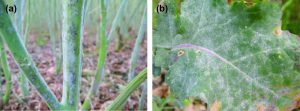Powdery mildew, caused by Erysiphe cruciferarum, is a sporadic disease and occurs mostly under humid conditions in thick crops and when nitrogen nutrition is good. Warm, dry climates with cool nights that favour dew formation initiate powdery mildew infection. Over summer the fungus survives on crop residue or host weeds. Spores produced on the crop residues are dispersed by wind, rain splash or insects the following year.
What to look for
The white powdery growth visible on the plant is primarily made up of spores and mycelium. The fungal spores are rapidly spread by wind from plant to plant and can germinate and infect without the presence of free water.
Small, white powdery spots first appear on the surface of older leaves. These spots can rapidly expand in size and coalesce to form a dense, white layer that can resemble talcum powder. Whole leaves can quickly become affected. The infected area is initially white and then turns black after a period of time. Stems and pods can also become covered. Severely affected pods have smaller seeds and can affect oil quality.
Management
- powdery mildew infection is not usually severe enough to warrant control.
- powdery mildew is very host specific. Rotation away from Brassica species will reduce the inoculum levels.
- there are no registered fungicides or seed dressings for the control of powdery mildew in Australia.
Please note: This book is also available on AppleBooks



